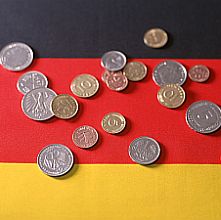
MINTs are fresher than BRICS, but don’t expect massive growth
February 3, 2014
Good News for Bats? Species Bouncing Back in Europe
February 3, 2014Chancellor Angela Merkel has been inaugurated for a third term and will once more preside over Germany in a ‘grand coalition’. This time around she may have been handed a poisoned chalice.
Germany faces significant economic challenges risks. The nation’s economic power and financial strength may be overstated. It remains vulnerable to continuing problems in Europe. In addition, the terms of the coalition (185 pages agreement –Shaping Germany’s Future) limits her operating flexibility.
Exporting German Troubles?
German economic strength relies on its export prowess. The assumption is that the country can de-couple from the Euro-Zone, increasing its focus on emerging markets. But German exports to European countries total around 69% of the total, including 57% to the member states of the European Union.
In 2012, Germany ran a trade deficit of Euro 27 billion with Russia, Libya, and Norway, mainly for energy imports. Germany also had trade deficits with Japan (Euro 4.7 billion) and China (Euro 11.1 billion).
In contrast, Germany had a trade surplus with the Euro-Zone (France, Italy, Spain, Greece, Portugal, Cyprus and Ireland) of Euro 54.6 billion. It also had a surplus with the US (Euro 36.2 billion) and UK (Euro 29.3 billion).
In effect, Germany’s overall global trade surpluses are reliant on exports to the Euro-Zone. Continued weakness in these troubled countries will affect Germany’s economic prospects.
German export performance also depends on the value of the Euro. If the euro continues to rise due the US continuing its quantitative easing plan for longer than expected, then Germany’s competitive position will weaken. High energy prices and the increasing problems in emerging markets will exacerbate its problems.
A slowdown in German exports will have secondary effects. The recovery in economies like Spain is dependent on exporting intermediate goods to Germany which are then re-exported as part of finished products. Reduction in German exports will decrease economic activity in these countries, in turn reducing demand for German exports within Europe.
The Sick Old Man of Europe, Again…
German industrial competitiveness is also overstated. Not so long ago Germany was regarded as the sick man of Europe.
Between 2000 and 2010, German productivity increased by a modest 0.6% per annum, roughly half the OECD average. Despite reforms which resulted in German real disposable income only increasing by around 50% of increases in France since 1997, the labour market remains inflexible.
The German banking system remains fragmented and weak. The problems of the State owned Landesbanks are well documented.
Germany’s infrastructure is aging, requiring investment. Energy costs remain high, some 30% above that of the rest of Europe and double that of the US, reducing competitiveness. High natural gas costs (four times the US cost) disadvantages its petro-chemical industry.
OECD and World Economic Forum studies rank Germany modestly in terms of education, communication infrastructure, financial system soundness and business environment. It ranks 106th for starting a firm, 31 for mobile broadband, 75 for soundness of banks, 127 for hiring and firing and 139 for wage flexibility.
Germany demographics, with an aging population, compound its problems. It has the highest median age at 45 years. In Europe in 1970, Germany’s dependency ratio (number of workers for each retiree) was 4.1. In 2010, it was 3.0 and is projected to go to 1.6 by 2050, only slightly higher than Japan.
The terms of the Grand Coalition do little to address pressing issues. If anything, it seeks to reverse some of theAgenda 2010 reforms launched in 2003 by now vilified Chancellor Gerhard Schröder, which did much to restore German economic strength.
Whatever their social merits, the minimum wage and increased retirement benefits will reduce competitiveness particularly in the old East Germany. The plight of younger workers is largely ignored.
Whatever the environmental benefits, the targeted increased share of renewable in energy production and winding down on nuclear power will increase costs. Constrained by rigid adherence to maintaining budget discipline and reducing debt, there are no major investment initiatives.
The Economist called the grand agreement a recipe for ‘die grosse stagnation‘.
The minimum wage and retirement benefit changes also are inconsistent with Chancellor Merkel’s austerity and restraint message to many troubled European nations. This will make it difficult for Germany to insist on further sacrifices from these countries.
Paying for Europe
Complicating Chancellor Merkel’s position is the European debt crisis, which remain in the background. The need to support the weaker countries may increase German problems.
Governments in the at-risk economies are unlikely to meet agreed budget deficit or debt level targets. Banks will face rising bad debt losses and require capital infusions. For both troubled sovereigns and banks, access to financial markets will remain restricted. Cost of commercial funding will remain above affordable levels. Further funding assistance may be required.
Euro-Zone members, including Germany, remain committed to avoiding the unknown risks of a default and departure of countries from the Euro. This presumably means that assistance will be forthcoming, although the exact form and attached conditions remains uncertain.
Peripheral countries will be forced to rely on the European Stability Mechanism (ESM) and European Central Bank (ECB) to provide funding. Unless the size of the ESM is increased, the ECB will be forced to provide financing directly or indirectly, funding banks to purchase government bonds which will be used as collateral for the central bank loan.
The TARGET2 (Trans-European Automated Real-time Gross Settlement Express Transfer System) is a payment system to settle cross border funds flows between Euro-Zone countries.
Before 2008, deficits of individual nations were financed by banks and investors. Since the commencement of the crisis, the absence of commercial financing has meant that national central banks in stronger countries have used the TARGET2 to finance peripheral countries without access to money markets to fund trade deficits and capital flight. This process will continue.
Over time, financing will become concentrated in official Euro-Zone agencies, the ECB and the TARGET2 system. Risk will shift from the peripheral countries to the core of the Euro-Zone, especially Germany and France. This reflects the reality that the stronger countries stand behind each of the support mechanisms.
The ESM relies primarily on contributions of four countries: Germany (27.1 per cent), France (20.4 per cent), Italy (17.9 per cent) and Spain (11.9 per cent). Individual countries are required to provide capital equivalent to their quotas.
While there is no legal provision that capital subscriptions or contingent commitments of remaining ESM members would increase, if Spain or Italy needs assistance, then the contributions of the remaining countries, especially France and Germany, may have to be increased to ensure the functioning of the ESM.
Germany is by far the largest creditor in TARGET2. The Netherlands, Finland and Luxembourg are the other creditors with all other Euro-Zone countries being net debtors within the system.
The TARGET2 net claims are not a true measure of the risk to the Bundesbank. The net balance would only be lost in the case of a breakup of the Euro-Zone and if sovereign central banks refuse to honour their debts. This risk is difficult to quantify. But there is a clear transfer of financing risk to the stronger core countries, ultimately affecting their financial position materially.
Beast of Burden
German guarantees supporting the ESM are Euro 190 billion, being Germany’s capital contribution to the ESM. But if the circumstances change and the ESM has to rely on purely German and France support, then Germany’s liability where recipients default could be much greater. There is also the indirect exposure via the ECB and the TARGET2 claims.
The size of these exposures and potential losses is large, in relation to Germany’s GDP of around Euro 2.5 trillion and German private wealth.
German household assets are estimated at Euro 4.7 trillion. Despite measurement issues, especially the attributed value of housing assets and pensions, Germans have lower than expected median net wealth within the Euro-zone.
German median net household wealth is estimated at Euro 51,400, well below that of Spain (Euro 182,700), Italy (Euro 173,500), Greece (Euro 101,900) and even Cyprus (Euro 266,900). This reflects a period of prolonged deflation since the creation of the Euro and low property ownership rates. Germany scores better on the average figure, reflecting wealth differentials and assets of rich families and foundations.
Germany also has substantial levels of its own debt (around 81% of GDP). If unfunded social security liabilities are included, then the level of German debt increases to over 190% of GDP, compared to 146% for Italy.
Truth Will Out
German voters generally approve of Chancellor Merkel’s handling of the European crisis, believing her reassuring message to the German public was that they are living in a prosperous recession proof economy and the Euro-Zone problems are largely contained.
In September 2013, German Finance Minister Wolfgang Schäuble mocked critics about doubting Europe’s recovery strategy.
In fact, the German led strategy for dealing with the European debt crisis shows limited progress and is unlikely to resolve the issues. Writing in theFinancial Times on 19 September 2013, former defence minister Karl-Theodor zu Guttenberg described the policy as: ‘First, keep all options open but do it decisively. Second, hesitate vigorously.’
A policy without debt write-offs and relief as well as major structural changes promotes European economic weakness, which will affect German performance. It will also require increasing financial support from stronger Euro-Zone nations for the peripheral nations.
At best, increased commitments to support its European partners will absorb German savings, crippling the economy. At worst, default of one of the weaker countries or a break-up of the Euro will result in large losses to Germany; the best estimates are in the range of Euro 750 billion to Euro 1,500 billion.
False Comfort
Germans are anxious to maintain their relative prosperity and central place in Europe. The need of the electorate was summed by Der Spiegel’s headline: ‘Germans want a Mutti’. In other words Germans want their mother (Mutti being the Chancellor Merkel’s popular nickname).
In a lack lustre election campaign which was spectacularly short of debate about substantive issues, the Chancellor’s success was the result of particularly inept opposition and an aura of calm and continuity. There was no clear vision of dealing with the urgent looming problems.
Voters in Germany have chosen to ignore that each step in the progress of the crisis has resulted in a transfer of risk, liability and losses to them. Given strong opposition to debt pooling and institutionalised structural wealth transfers, their eventual reaction to revelation of this increasing commitment and their status as the ‘permanent creditor‘ within Europe is unknown.
The catalyst could be actual cash transfers. This would be triggered by either losses on direct loans to peripheral nations or losses sustained by the ESM or ECB resulting in a cash call to recapitalise these entities.
German politicians and policy makers clearly fear voter reaction to such an event. They have gone to extraordinary lengths to avoid this eventuality, including suggestions of 50 year no interest loans to Greece to avoid the need for further write-offs or routing payments to cover debt via the European Union budget.
German history is one of monumental reverses and extremes. Only time will tell whether, the nation is on the verge of yet another one of these events.
Regards,
Satyajit Das
for The Daily Reckoning Australia
© 2014 Satyajit Das
Satyajit Das is a former banker and author of Extreme Money and Traders Guns Money
Related Articles:
- European Governments of the Eurozone are Separately Responsible for Their Euro-debt
- German Bonds – Just Like a Lead Zeppelin
- Whiskey Gunpowder
- The Wrecks and Smash-Ups Damaging Europe’s Economy
- The Real Story Behind Germany’s Gold Recall
About the Author
Satyajit Das is a 30-year financial market veteran. He is author of Extreme Money and Traders Guns Money.



